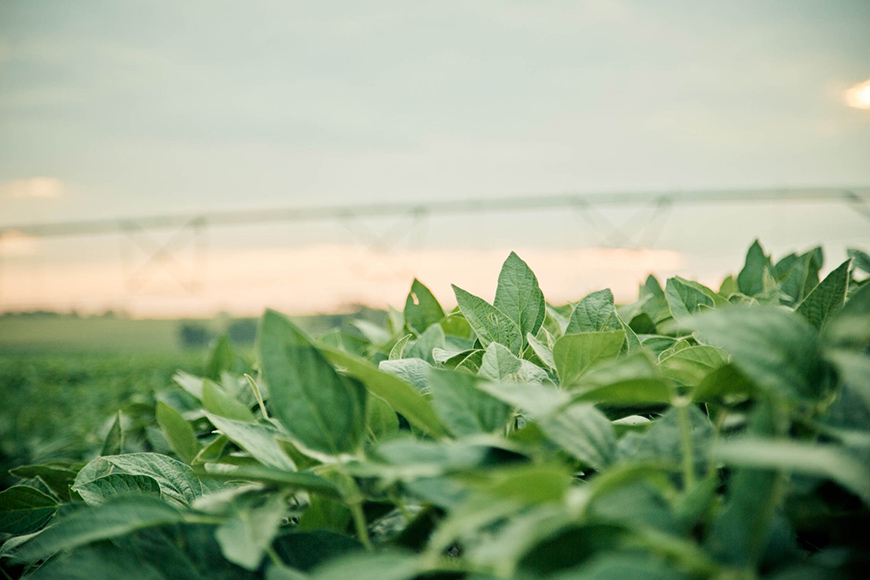High-Potential Soybean Traits Require High-Precision Management

As the 2019 growing season goes into the history books, you’re probably well on your way to creating your 2020 farm plan. If you grow soybeans and are considering your options for next season, it’s important to choose the right genetics and trait package for your operation to ensure you have the right crop protection plan in place for next season’s potential challenges.
For example, would Roundup Ready 2 Xtend® soybeans, which contain both dicamba and glyphosate herbicide tolerance, work best for you? Or would Enlist™ soybeans, which are tolerant to 2,4-D choline, glyphosate and glufosinate, be a better choice?
Here’s what you should consider when choosing next season’s soybean seed trait package and a matching crop protection plan.
Choosing the right trait package is the other half of the seed decision. This involves choosing the right herbicide package, taking into account what specific weeds are yield limiting. For example, waterhemp is becoming more common and has been present on acres in 2019 where it has never been seen before. If waterhemp is an issue on your farm, having the ability to use a herbicide with efficacy on that weed in-season and being able to apply that herbicide effectively is a critical component in your trait package decision. If marestail is an issue on your farm, thinking about these same issues, but instead focusing on early season management, is critical to achieving successful weed control.
Which trait package allows you to best control the weeds that are a yield limiting factor in your field? Understanding the weeds that pose the biggest challenge in terms of control on your farm, assessing the herbicide options available to you with a given trait package, and knowing the associated label restrictions and risks will help you determine the trait package you choose.
Having a healthy root system is particularly important for your soybean plants, as it is vital for carrying water and nutrients into the plant. A large, healthy root system in August can take advantage of late-season rains to achieve maximum pod fill, which is the critical aspect in achieving high-yielding soybeans. Anything you can do to encourage a healthy root system from the time your seed is planted to harvest is going to have a positive impact on yield potential.
Talk with your agronomist now about your soybean trait package and crop protection needs for 2020, as well as the burndown options you have for this fall, so you can get the season off to a quick, successful start.
All photos are either the property of WinField United or used with permission.
© 2019 WinField United. Important: Before use always read and follow label instructions. Crop performance is dependent on several factors many of which are beyond the control of WinField United, including without limitation, reduced performance, and/or crop damage due to environmental factors such as rainfall, temperature, crop production patterns and other factors. Growers are encouraged to consider data from multiple locations, over multiple years, and be mindful of how such agronomic conditions could impact results. Answer Plot, R7, Warden and WinField are trademarks of WinField United. Roundup Ready 2 Xtend® is a trademark used under license from Bayer Group. Enlist® is a trademark of Dow AgroSciences LLC. All other trademarks are the property of their respective owners.
For example, would Roundup Ready 2 Xtend® soybeans, which contain both dicamba and glyphosate herbicide tolerance, work best for you? Or would Enlist™ soybeans, which are tolerant to 2,4-D choline, glyphosate and glufosinate, be a better choice?
Here’s what you should consider when choosing next season’s soybean seed trait package and a matching crop protection plan.
1. Understand the difference between genetics and trait package.
There are two components to the soybean seed purchase discussion: genetics and trait package. The genetics component involves placing the right seed on the right acre. Understanding the disease tolerance, soil type preferences, and of course overall yield potential play into the genetics side of this decision. Using tools like Soybean Performance Trial data from the Answer Plot® program and data from local Insight Trials in the R7® Tool lets you see what varieties are performing well in a given area and, more importantly, what varieties best match a given soil type or management style. This helps you optimize yield potential on a given acre by placing the right variety on that acre.Choosing the right trait package is the other half of the seed decision. This involves choosing the right herbicide package, taking into account what specific weeds are yield limiting. For example, waterhemp is becoming more common and has been present on acres in 2019 where it has never been seen before. If waterhemp is an issue on your farm, having the ability to use a herbicide with efficacy on that weed in-season and being able to apply that herbicide effectively is a critical component in your trait package decision. If marestail is an issue on your farm, thinking about these same issues, but instead focusing on early season management, is critical to achieving successful weed control.
Which trait package allows you to best control the weeds that are a yield limiting factor in your field? Understanding the weeds that pose the biggest challenge in terms of control on your farm, assessing the herbicide options available to you with a given trait package, and knowing the associated label restrictions and risks will help you determine the trait package you choose.
2. Apply an effective fall burndown.
Regardless of the soybean trait package you choose, consider doing a burndown application now to manage weeds such as marestail, perennials such as dandelion, or winter annuals such as chickweed. That “start clean, stay clean” approach doesn’t begin with spring planting; it starts right now. Planting into clean fields this spring will be absolutely key and will give you a boost, regardless of the trait package you select.3. Include a seed treatment.
Be sure to protect your seed from early-season disease and insect threats with a high-quality seed treatment. Warden® CX seed treatment can help defend against early-season water molds like pythium and phytophthora root rot, providing extra protection heading into the growing season. Remember, too, that when new soybean genetics are released into the market, disease tolerance is one of the most difficult aspects of a variety for breeders to fully understand until it is seen commercially in the field across broad acres and environments. For this reason, it is important to select the right seed treatment for your acres, and using seed treatments like Warden CX on brand new varieties can help reduce risk when they are being planted in fields with a history of disease pressure.Having a healthy root system is particularly important for your soybean plants, as it is vital for carrying water and nutrients into the plant. A large, healthy root system in August can take advantage of late-season rains to achieve maximum pod fill, which is the critical aspect in achieving high-yielding soybeans. Anything you can do to encourage a healthy root system from the time your seed is planted to harvest is going to have a positive impact on yield potential.
4. Know what you’ve planted where.
When you do make a trait decision, either make that same decision for your whole farm or keep very accurate records of what type of soybeans you’ve planted and where you’ve planted them. You may purchase several types of soybean seed from several different sources. Keeping good records will keep you or your retailer from spraying the wrong herbicide on the wrong beans and harming your crop. Ensuring that communication is kept at a high level between you and your retailer will go a long way toward making sure both seed and herbicide ends up where they are intended.5. Understand your environment.
Know the herbicide your soybeans are traited for and familiarize yourself with any label restrictions it carries. Wind speed and direction, buffer zones, temperature and sensitive crops are just a few of the factors that can play a role in when you can spray and when you can’t. Know what’s planted in your adjacent fields and what’s planted in your neighbor’s fields to avoid problems. Contact your local trusted advisor to help counsel you on the restrictions and environmental issues to consider in your particular area.Talk with your agronomist now about your soybean trait package and crop protection needs for 2020, as well as the burndown options you have for this fall, so you can get the season off to a quick, successful start.
All photos are either the property of WinField United or used with permission.
© 2019 WinField United. Important: Before use always read and follow label instructions. Crop performance is dependent on several factors many of which are beyond the control of WinField United, including without limitation, reduced performance, and/or crop damage due to environmental factors such as rainfall, temperature, crop production patterns and other factors. Growers are encouraged to consider data from multiple locations, over multiple years, and be mindful of how such agronomic conditions could impact results. Answer Plot, R7, Warden and WinField are trademarks of WinField United. Roundup Ready 2 Xtend® is a trademark used under license from Bayer Group. Enlist® is a trademark of Dow AgroSciences LLC. All other trademarks are the property of their respective owners.




.jpeg?ext=.jpeg)